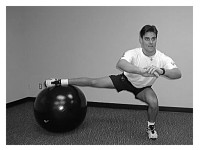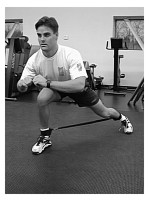






 |


Summer Choices
Hockey-Specific Cond...
Prevent Ankle & Knee
Yr-Round Train. Sched.
Post-Season - May 31st
Quickness & Agility
Balance Training
Improving Player Dev.
Flexibility for Skill
Overload Skating
Proven Training Tips
Anaerobic Running
Youth Strength Training
About Peter Twist

Camps
SportConditioning.ca
By Peter Twist MPE, BPE, CSCS © 2000 Peter Twist Peter Twist is President & CEO of Twist Conditioning Inc and the former Coach of Conditioning & Player Development for the Vancouver Canucks. He has authored dozens of articles on athlete development in scientific journals, written two books on conditioning and is currently finishing a third on core stability. Peter Twist runs weekly sport-specific conditioning camps for professional athletes, high school students, and adult recreational athletes, as well as one-on-one training and team clinics. He can be contacted through www.sportconditioning.ca or 604-904-6556. Strength: Build strength and power in the movement patterns and speeds that you need in a game. For hockey, you don't want to be big and slow - rather strong and fast is the goal. A higher tempo lift along with movement patterns which mimmick sport technique (i.e. the skating stride, a slap shot) transfer well to the game environment. With free weights, tubing, and medicine balls you can get creative and invent exercises more specific to your sport demands. Quickness and Agility: As hockey involves read-react-and explode patterns, quickness and agility are key determinants of success. Short explosive bursts along with mobility and varied movement skills will be drawn upon in games, such as responding to turnoverS with quick cross overs to jump into position for an offensive opportunity. Injury Prevention: The majority of sport injuries occur when decelerating or braking. A quick stop, for example, often results in ankle and knee injuries. Many athletes are 'set up' for injury because of dysfunctional fitness programs. Most fitness workouts place participants in seated positions lifting through a very restricted and controlled range of motion, usually in a straight-ahead pattern, such as a seated leg extension. In hockey, you are in a standing position and move through multi directional movement patterns in random sequences. To prevent injury, you need to train to stop - this includes landing and balancing. And your strength exercises should include lateral movement and single leg work. Two exemplary exercises using the Stability Ball and Sidestep Strength Tubing are illustrated here. Exercise 1: Single leg Squat with groin flexibility/balance  Exercise 2: Independent leg 45 degree power stride with sidestep strength tubing  Speed Center: I call your 'core', which includes your abdominals, hips and low back, the 'Speed Center' because these muscle groups initiate all movement. A golf swing, a football pass and a hockey slap shot all originate from the core. Likewise, in contact sports like hockey, all force is ultimately absorbed by the core. The core delivers force and absorbs force. Floor-based sit ups are a good start but just build a foundation. My athletes do 75 % of their core work in a standing position, with partner resistance and medicine balls, as well as stability ball exercises. Build from the core to the periphery - first develop core strength and then work the legs and arms. Energy: Nutrition is the key link between hockey conditioning and game performance. Your pre-game fueling should begin the day before your game, taking several meals to top up your sport fuel tank - you cannot supply all of the fuel needed from just one meal. Eat your last big meal 4 to 6 hours before the game, to allow for full digestion. Carbohydrates supply the fuel for sport performance, while fruits and vegetables supply the vitamins and minerals vital to the energy production process. Fluids: During your game, excess heat is dissipated in the form of sweat - your body cools when the sweat evaporates. The rate of heat production by active muscles is 100 times that of resting muscles. Water is also required for the chemical reactions in the muscles that release energy for sport movements, plus your water level determines the performance of your aerobic system. Maintaining an adequate water level is critical for cooling, energy production, and oxygen delivery. Unfortunately, your thirst mechanism is not triggered until you have already lost 1 % of your body weight in water. For optimal conditioning and game performance, you have to drink before you are thirsty! |
 project
project© 1999 DavidSport Inc. All Rights Reserved. Disclaimer